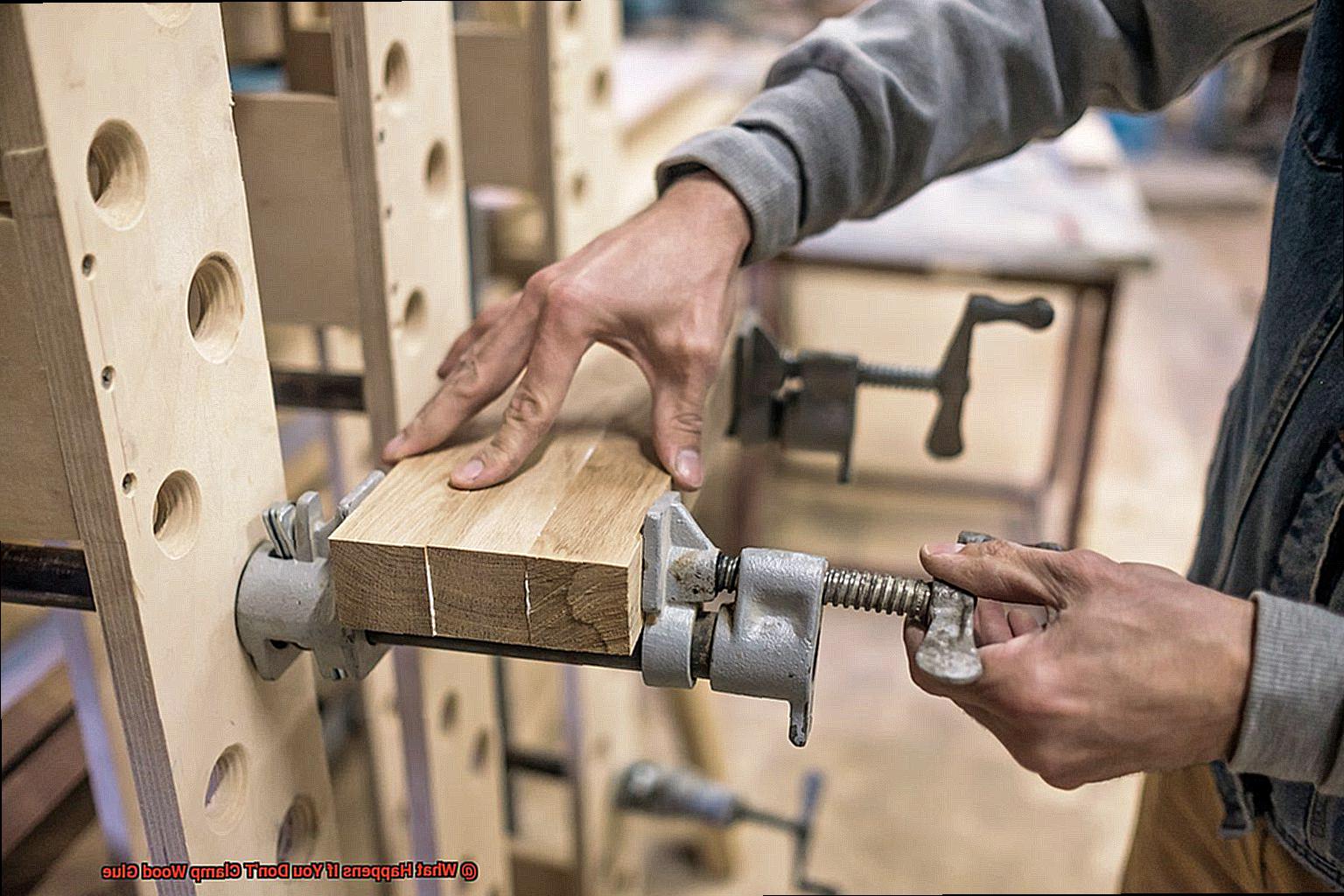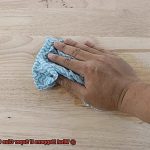Woodworking, a realm where artistry and craftsmanship intertwine, demands unwavering attention to detail. Amidst the thrill of creating masterpieces, it’s easy to overlook seemingly trivial steps – like clamping wood glue. But make no mistake, my fellow woodworking enthusiasts, neglecting this vital process can unleash a whirlwind of consequences.
Picture this: you’ve poured your heart and soul into crafting a breathtaking piece of furniture, only to watch it crumble before your eyes. The culprit? Insufficient clamping during glue application. This grave oversight weakens the bond between wooden pieces, leaving your creation vulnerable to warping, splitting, or even complete disintegration.
Yet the repercussions extend beyond mere structural disappointments. For seasoned professionals and aspiring artisans alike, reputation is everything. One flawed project could tarnish your name forever, casting doubt on your expertise and craftsmanship. Word spreads like wildfire in our community – clients entrusting their dreams to you deserve nothing short of perfection.
But wait. Even if catastrophe doesn’t strike immediately, inferior joints due to improper clamping can drastically shorten the lifespan of your work. Your customers invest their hard-earned money in your creations with the expectation of longevity. It falls upon us to deliver on that promise.
So why is clamping wood glue such a game-changer? How can we ensure proper techniques to avoid these potential tribulations? In this captivating blog post series, we’ll explore the science behind adhesive processes, unveil the detrimental effects of neglecting clamping, and provide invaluable tips for safeguarding the quality of your woodworking projects.
Stay tuned for our next installment as we plunge deeper into the art of clamping wood glue. We’ll uncover best practices for various joint types and expose the secrets behind achieving impeccable bonds that stand the test of time. After all, as wise woodworkers say, “Measure twice, cut once, and clamp with unwavering diligence.”
What is Wood Glue?
Contents
When it comes to woodworking, strong and durable connections between wooden pieces are essential. That’s where wood glue, also known as carpenter’s glue or PVA glue, comes into play. In this blog post, we will delve into the world of wood glue, uncovering what it is and why it is a must-have for any woodworking enthusiast.
What is Wood Glue?
Wood glue is a specialized adhesive designed specifically for bonding wood surfaces together. It is made from polyvinyl acetate (PVA), a synthetic polymer that forms a powerful bond as it dries. This water-based glue is not only easy to clean up with water before it dries but also non-toxic and safe to use, making it an excellent choice for various woodworking applications.
How Does Wood Glue Work?
Wood glue works by penetrating the wood fibers and creating a strong molecular bond as it dries. When applied to two mating surfaces, the glue seeps into the pores of the wood, ensuring a tight and secure connection. As the water in the glue evaporates, the polymer chains cross-link and harden, resulting in a durable and long-lasting bond between the joined wood pieces.
Advantages of Wood Glue:
- Strong and Durable Bond: Wood glue provides a bond that can withstand the stresses and strains typically encountered by wooden structures. Whether you’re building furniture or crafting intricate wooden sculptures, wood glue ensures that your creations stand the test of time.
- Gap-Filling Properties: Thanks to its thick consistency, wood glue has excellent gap-filling properties. It can fill small gaps and irregularities between wood surfaces, ensuring a tight connection even in less-than-perfect conditions.
- Resistance to Heat and Moisture: Wood glue exhibits remarkable resistance to heat and moisture, making it suitable for both interior and exterior applications. Whether your project is indoors or exposed to the elements, wood glue will remain steadfast.
The Importance of Clamping:
When using wood glue, it’s crucial to utilize clamps to hold the pieces together while the glue dries. Clamping ensures a strong bond, prevents movement or shifting during drying, and helps squeeze out excess glue for a thin and even layer. Neglecting to use clamps can lead to misalignment, uneven edges, extended drying time, and weaker adhesive properties.
Why Clamping is Necessary for Wood Glue
Today, we’re delving into the captivating world of wood glue and uncovering the vital role that clamping plays in achieving a robust bond. So grab your favorite cup of joe, settle into your workshop, and let’s embark on this enlightening journey.
The Importance of Alignment:
When wood glue is applied between two pieces of wood, it starts off with a high liquid content. As it dries and undergoes the curing process, the glue transforms into a solid state. Without clamping, the pieces may shift or separate slightly, resulting in feeble joints. We all want our projects to withstand the test of time, don’t we?
Even Distribution of Glue:
Clamping ensures that the glue is evenly distributed across the wood surfaces, guaranteeing proper adhesion. This prevents the formation of air pockets and gaps that can weaken the bond and compromise the joint’s strength. Think of clamping as your secret weapon for achieving a seamless connection.
Pressure Makes Perfect:
The amount of pressure applied by the clamp is crucial in creating a strong bond. It helps squeeze out excess glue and ensures sufficient contact between the adhesive and the wood surfaces. Don’t hold back – give it a good squeeze.
A Variety of Clamps:
Different projects call for different clamps. For larger endeavors, bar clamps or pipe clamps are commonly used due to their wider reach and adjustable nature. On the other hand, smaller projects may require spring clamps or C-clamps for their versatility and ease of use.
Follow Manufacturer Guidelines:
Each type of wood glue may have specific recommendations for clamp time and pressure. It’s essential to read and follow these guidelines to achieve optimal bonding strength and ensure a successful woodworking project.
Potential Consequences of Not Clamping Wood Glue
Today, we delve into the potential consequences of not clamping wood glue. Imagine this: you’ve painstakingly prepared your project, applied the perfect amount of glue, and then… skipped the clamping step. Uh-oh. Let’s explore the possible outcomes and understand why clamping is vital for successful woodworking.
Weak and Unreliable Bonds:
Without proper clamping, your hard work may result in weak and unreliable bonds between pieces of wood. We all desire projects that stand the test of time, right? Clamping ensures that the glue dries and sets in the correct position, creating a robust and enduring bond that can withstand everyday use.
Shifting and Misalignment:
Ever experienced that sinking feeling when your project ends up with unsightly gaps or misalignment? Not clamping wood glue can lead to just that. Without clamps, the wood pieces may shift or move during drying, resulting in uneven joints that compromise both strength and stability.
Prolonged Drying Time:
Waiting for glue to dry can feel like watching paint dry, but without proper clamping, it can be worse. Clamping helps squeeze out excess glue, allowing for a tight connection between wood surfaces. Without this pressure, excess glue may remain trapped, slowing down drying and potentially affecting bond strength.
Joint Failure:
Imagine finishing your masterpiece only to have it crumble in your hands. Not using clamps with wood glue can lead to joint failure. The lack of proper pressure and support from clamps prevents the glue from establishing a strong bond between wood surfaces. This can result in joints that easily break apart or separate under stress or regular use.
Aesthetics Matter Too:
We all want our projects to look as good as they function, right? Skipping clamping can impact the overall aesthetics of your project. Without proper clamping, visible gaps or misalignment between wood pieces can occur, particularly when working with precise joints or lighter-colored woods where imperfections are more noticeable.
Misalignment and Uneven Edges
In the world of woodworking, precision is paramount. Whether you’re crafting a delicate jewelry box or a sturdy dining table, the quality of your work hinges on the strength and stability of your joints. However, misalignment and uneven edges can plague even the most skilled woodworker. But fear not. By harnessing the power of clamps, you can conquer these challenges and create flawless woodwork that stands the test of time.
Consequences of Neglecting Clamps:
- Misalignment: Without clamps, meticulously measured and cut pieces can shift during the drying process, resulting in unsightly gaps and compromised structural integrity.
- Uneven Edges: Inconsistent pressure across the glued joint can lead to uneven surfaces, making it difficult to achieve that coveted smooth finish.

The Magic of Clamps:
- Pressure for Perfect Bonding: Clamps firmly hold wood pieces together, ensuring they remain in place until the glue dries completely. This facilitates a strong bond that minimizes the risk of shifting or movement.
- Even Glue Distribution: Proper clamping promotes an even spread of glue between wood surfaces, maximizing bonding effectiveness. It allows the glue to penetrate deep into the wood fibers, ensuring long-lasting strength.
Choosing the Right Clamps:
- Consider Pressure Requirements: Different projects demand varying degrees of pressure. Select clamps that provide sufficient force without damaging delicate materials.
- Match Clamp Type to Project Needs: Bar clamps, pipe clamps, and spring clamps each have their own unique strengths and are suited for specific woodworking tasks. Choose wisely.
Strategic Clamp Placement:
- Achieve Uniform Pressure: Position clamps strategically along the glued joint to distribute pressure evenly across all contact points.
- Balance Strength and Aesthetics: Prevent unsightly marks or indentations on your precious woodwork by using protective pads or blocks. Preserve the beauty of your project while ensuring its structural integrity.
Gaps and Voids in the Glue Joint
A flawless glue joint is the heart and soul of any woodworking masterpiece. But, alas, gaps and voids can sneak in, tainting the beauty and strength of your creation. Fret not. In this blog post, we shall explore the causes of these pesky gaps and impart proven remedies to achieve impeccable glue joints.
Insufficient Pressure:
The absence of adequate clamping pressure is a recipe for disaster, as it invites gaps and voids to take center stage. Air pockets may form between the wood surfaces, weakening the joint. Remember, clamps are your steadfast companions in this quest for perfection.
Improper Glue Application:
Uneven distribution or insufficient application of glue is a culprit behind weakened joints and unsightly gaps.
Premature Clamp Removal:
Impatience can be your undoing in woodworking. Removing clamps too soon releases the pressure holding the pieces together, giving birth to gaps in the joint.
Conclusion:
Crafting seamless wood joints demands attention to detail and adherence to proper techniques. By applying adequate pressure during clamping, ensuring even glue distribution, and allowing sufficient drying time, you can bid adieu to gaps and voids in your glue joints. Embrace clamps as unwavering allies, and revel in the magnificence and strength of your woodworking creations.
Extended Drying Time
One crucial step that often gets overlooked is clamping. Not clamping wood glue can lead to extended drying time, and we’re going to explore why.
When you meticulously apply the perfect amount of wood glue to carefully prepared surfaces, you expect a strong bond that withstands the test of time. But without clamping, those wood pieces may not make the intimate contact they need for a strong bond. This lack of pressure creates air pockets and gaps, hindering the glue’s ability to penetrate deep into the wood fibers.
These sneaky gaps become barriers for the glue, preventing it from fully bonding and penetrating into the wood fibers. As a result, drying and curing times are prolonged. Waiting around for glue to dry is not anyone’s idea of a good time, especially when project schedules or limited time are factors.
Extended drying time also increases the risk of accidental movement or disruption of the glued joint. Even if you think you can keep those pieces in place without clamping, accidents happen. Misalignment and weak joints are just around the corner when they do.
Moreover, extended drying time affects the quality of your finished product. The longer the glue takes to cure, the more vulnerable it becomes to environmental factors like temperature and humidity. These changes can impact the drying process and potentially weaken the bond, putting your hard work at risk.
Weaker Adhesive Properties
Today, we’re delving into a topic that may not be the most glamorous, but it is undeniably crucial for the success of your projects – the proper use of clamps when applying wood glue. You might be tempted to skip this step and simply slather on the adhesive, but beware. Neglecting clamping can result in weaker adhesive properties and a whole lot of frustration. So, let’s roll up our sleeves and explore why clamping is of utmost importance in creating robust bonds between wood surfaces.
The Power of Pressure:
When it comes to gluing wood pieces together, pressure is your secret weapon. By utilizing clamps, you ensure that the glued surfaces are securely held together, allowing the glue to cure and bond effectively. Without this external force tightly pressing the wood pieces, the glue won’t penetrate the wood fibers as it should. And what does that mean? A feeble joint that’s prone to failure over time. Let’s avoid that catastrophe.
Avoiding Gaps and Voids:
Picture this: you’ve carefully applied your wood glue and are eagerly awaiting its setting. But hold on. Without clamping, there’s a higher likelihood of gaps or voids between the wood surfaces. These bothersome crevices can form due to uneven pressure distribution or movement during drying. Unfortunately, when the glue hardens, it may not completely fill these gaps. That’s right – weak bond alert.
Even Distribution Matters:
Now, let’s discuss another vital reason why clamping is paramount – ensuring the even distribution of glue. When clamping is absent, it becomes challenging to spread the adhesive evenly across the entire surface. Uneven distribution means some areas may have insufficient adhesive coverage, resulting in weaker spots compared to the rest of the joint. Our goal is a robust bond from top to bottom, isn’t it?
LLQa_koALNA” >
Also Read: How To Glue Plywood Together?
Conclusion
In conclusion, failing to clamp wood glue can lead to disastrous consequences for your woodworking endeavors. The absence of proper clamping weakens the bond between wooden pieces, leaving your masterpieces vulnerable to warping, splitting, or even complete disintegration. This not only compromises the structural integrity of your work but also tarnishes your reputation as a skilled craftsman.
Moreover, neglecting to use clamps during the wood glue application process can result in extended drying time and weakened adhesive properties. Without the necessary pressure from clamps, the glue fails to penetrate deep into the wood fibers, resulting in unsightly gaps and voids that undermine the joint’s strength. This prolonged drying time increases the risk of accidental movement or disruption of the glued joint and ultimately impacts the overall quality of your final product.
To avoid these potential tribulations, it is absolutely essential to employ clamps when applying wood glue. By utilizing clamps, you ensure a robust bond that securely holds the pieces together while the glue dries. This promotes an even distribution of adhesive and prevents any unsightly gaps or voids from forming. Keep in mind that different projects may require specific types of clamps based on pressure requirements and project needs; therefore, choosing wisely is imperative.
Remember, woodworking demands meticulous attention to detail. By diligently employing clamps when using wood glue, you guarantee that your creations are not only visually stunning but also structurally sound and built to withstand the tests of time.






